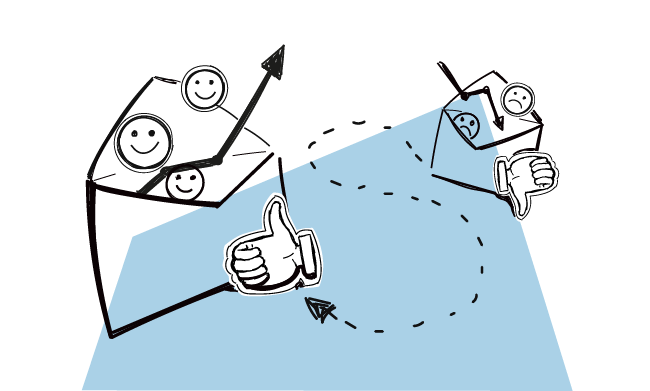Writing a good cold email is harder than it seems.
In this blog post we’re showing you real-life examples of good and bad emails. Use them for inspiration when you’re going to create your own.
I asked cold email expert and our partner Laura Lopuch to chime in on the subject and show how she went from writing terrible cold emails to successful ones.
Take over, Laura.
***
When I was first starting out with cold emails, I wouldn’t have known a bad one if it flopped wildly at my feet like a dying fish.
Instead, I would’ve looked at it, mystified, and said: “Hm, looks like an email. Wonder why it’s dying?”
And that, my friend, is why the first three months of me cold emailing was a tornado of swirling self-doubt and frustration.
Faithfully I kept sending 25 new cold emails a week, pitching new leads. I tweaked and edited my cold email, enduring the never-ending silence.
It felt like I was emailing the Internet’s trash can.
Why couldn’t I get a reply?
Was there something wrong with my offer?
Or worse: something wrong with me?
The Internet is flooded with cold email examples, all claiming they’re “great cold emails.” Which is a bad thing.
Because: how do you know what a bad cold email is when nobody shows one compared to a good cold email?
And if you don’t know what a horrible cold email looks like, how can you improve your cold email into a winning one?
Today we’re changing that.
In this post, I’ll do two teardowns:
- one of a horrible cold email (the one I sent in month #1 of cold emailing)
- and a winning cold email (one that catapulted my business from $200 to $5,000 months)
Before we get into the teardowns, a cold email has five parts:
- From name
- Subject line
- Hook
- Pitch
- Ask
All parts need to work together to create cold email glory. Don’t worry — I’ll show you each part and what its job is.
Let’s start with the horrible cold email.
My Horrible Cold Email
Here’s the entire cold email in all its horrible glory:
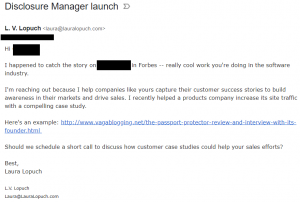
Horrible Cold Email: From Name
The from name is the email sender’s name.
In this bad cold email, the from name is L.V. Lopuch:

The from name is vitally important.
Because of how the inbox is organized, the from name is the first thing your cold email reader sees. Super Office’s research found that 45% of subscribers say they are likely to read your email because of who it’s from.
Look at how the Gmail app showcases the from name:
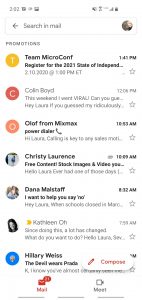
Even in the desktop Gmail, the from name is the first item:
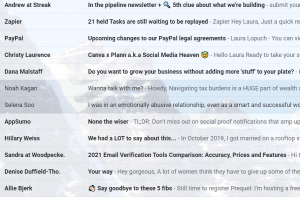
Therefore, having a real, human-sounding from name is the first test your cold email must pass. Your from name must build trust immediately.
I’m not J.K. Rowling, so I can’t get away with using initials in my from name.
Horrible Cold Email: Subject Line
I like how short this subject line is. It stands out in the inbox.

However, a subject line’s number one job is:
To get your cold email opened.
I don’t know if this email was opened.
Because I committed a serious error before I clicked “send” on this cold email: I forgot to install tracking software to see if this email was opened.
Without that insight, I have no idea if this subject line did its job… or not. Which gives me no idea if I need to edit or keep this subject line.
Assuming this subject line failed, I’d try out these new ones:
- Congrats on your Forbes feature!
- your recent launch / Disclosure Manager
- Forbes / your recent launch
Horrible Cold Email: Hook
The first 1-3 sentences in an email is called the hook. Think about those sentences reaching out to grab your reader’s attention, hooking their gaze like a fish hook in their cheek.
Here’s the hook in this bad cold email:

This tired hook is half-heartedly trying to snag my reader’s attention in a “hey, maybe you might care” way.
If I’d used a compliment as my hook, my email would be stronger, like:
“Congrats on your recent feature in Forbes! I love how [company] is doing [specific compliment, like: helping entrepreneurs find more tax breaks without an accountant’s help].”
Horrible Cold Email: Pitch
The third section of a cold email is the pitch.
If you think “cold email,” I’m guessing the pitch is what you think of. Yep, this is the selling part of your cold email.
If you want my winning cold email pitch, it’s inside this template.

Why this pitch failed can be summed up in one word: irrelevant.
I don’t answer the question in my cold email reader’s mind: “What’s in it for me?” Instead, I blab on and on about me. I even started every sentence with “I.”
I committed the cardinal error of cold emails: don’t talk about me. Talk about my cold email reader’s problem.
Corbett Barr, host of the The Fizzle Show, recently said:
“99% of them [cold emails] I delete, I don’t even bother reading them. The only one that caught my attention is when someone said, ‘Hey, I think we can improve your email deliverability rate by such and such. I want to show you how we can make it better.’ They made a video, custom for us.
Of course I’m going to watch this, there’s value for me whether or not I hire that person. It’s part of what I’d be paying for. Of course I’ll watch it. It’s one of the only ones that have gotten my attention.
Not only show and don’t tell [in your cold email]. But show in a way that has that person’s business or logo front and center, so they can’t help but click to see what you’ve made for them.”
My cold email reader didn’t care because I didn’t make them care by showing value. Instead, they clicked delete.
Horrible Cold Email: Ask
The call to action is where you ask your cold email reader to take action. To do something. Specifically, the action that you need them to take… and not the action of clicking delete.
Which is certainly why this cold email was deleted for two big reasons:
- Using the word “should”
- Lack of clarity on next steps
1. Using the word should
Ack, there’s no great way to put this politely. Using the word “should” brings up awful connotations of the mean little voice in your head.
As Dani DiPirro writes, “…when most people think the word ‘should,’ there’s a knee-jerk reaction to rebel against it, or at least feel resentful of it (if you’re not the rebelling type). Rather than empowering you to do something else, should actually reinforces what you’re not doing.”
Using the word “should” in my call to action lumps my ask into that category of whiney, not-good-enough feelings.
2. Lack of clarity on next steps
My cold email reader doesn’t know what happens after they say yes.
My ask is littered with confusion:
- What does “a short call” mean? Depending on your day, that call could be 5 or 30 or 60 minutes.
- Will this call be happening on the phone or via Zoom or Skype?
- What exactly will we be talking about?
Each of those questions throws up a roadblock preventing my cold email reader from saying yes.
What a winning cold email looks like
This cold email is the one that I refined after three months of endless testing. It’s a real-life cold email that I sent and got a reply back the very same day.
Malcolm, the CEO who I cold emailed, even cc’ed Shawnee, his VP of Content Marketing, to hand off this project.
By doing that, he signals to Shawnee that he wants her to potentially work with me. Huge credibility boost for me.
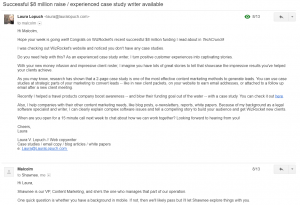
Winning Cold Email: Subject Line
I love this subject line.
It’s one of the best ones I’ve written and reliably gets opened when I use it (or a variation) for a cold email.

Why this subject line works so well:
- Pairs up a compliment with a sneak peek into my pitch
- Hints at my cold email’s body while invoking curiosity
- Has unusual punctuation / the backslash
- Bit longer than your normal cold email subject line
- Super relevant by referencing the compliment
- Feels personal, human, and not auto-populated with form fields
Winning Cold Email: From Name
Oh hey, this email looks like it’s coming from a real person!

My full name — Laura Lopuch — is in the from name. No initials or uncertainty as to who I am. Look at that, there’s even a smiling picture of me.
All those items help my email get opened and build trust instantly.
Winning Cold Email: Hook
Remember, the hook is the first 1-3 sentences of your cold email. A good hook immediately snags your reader’s attention.
My favorite way — and one I learned through lots of trial and error — is to give my reader a compliment.
“Persuade a person on a gut level, and the feeling will last and last. And last,” writes Andrew O’Connell in the Harvard Business Review. Flattery operates on that gut level, which is far stickier than what your cold email reader believes on a conscious level.
Using a compliment in your cold email’s hook is a top-notch way to grab your reader’s attention. Humans are selfish. We only care about ourselves.
But deliver the compliment in the right way: authentically and enthusiastically and use specifics, like how I complimented Malcolm:

By referencing where I read that information, I give credibility to my info without making it seem like I’m a weird Internet stalker.
By the way, I do fall into the Weird Internet Stalker camp because I did research on Malcolm and WizRocket before writing this email. Which is why I knew about their successful funding round.
In the next section, I’ll share more about the research I did.
Winning Cold Email: Pitch
This pitch is focused on answering Malcolm’s question: “What’s in it for me?”
At the time I sent this cold email, I was pitching case studies. To determine if Malcolm was a good fit for my services, I researched his company, website, and marketing materials. To find an answer to my question: does he have any case studies?
My research found his website didn’t. Meaning: he had a problem I could solve.

So I pitched my offer — case studies — as a solution to a problem he has — no case studies. Inside my pitch, I used a stat to back up my point on why adding case studies to his marketing is a win, especially in light of his company’s recent funding round and need to grow quickly.
“If you’ve done your research and understand their persona, you can tell them how your call is going to bring them closer to achieving X goal that you’ve identified. After all, hitting their goal is what truly matters to them.,” says Rachel Williams, Director of Sales at Calendly.
Winning Cold Email: Ask
When I was regularly sending cold emails to get new clients, this was my go-to ask: “When are you open for a 15 minute call next week?”
See, I used it in this winning cold email:

It worked, but now I like to use a more straight-forward ask:
“Are you open next Tuesday or Thursday at 9am or 1pm PT for a 20-min Zoom video chat to discuss further?”
This ask combines the power of:
- clarity
- assertiveness
The clarity comes from helping my cold email reader know exactly what happens after they say yes: we’ll get on a Zoom call for 20 minutes on Tuesday or Thursday at 9am or 1pm.
The assertiveness helps them feel secure. I’m not asking them to decide what the next step is, like this ask would: “Let me know if you’d like to chat.”
Rather I’m taking the lead, thereby showing my expertise and making them feel secure in their decision. Which is how I got a new client worth $20,000 with one cold email using this template.
How to apply these teardowns in your cold emails:
From the horrible cold email, the lessons are:
- Make sure your from name sounds like a human
- In your pitch, answer your cold email reader’s question: “What’s in it for me?”
- Watch your language in your ask
From the winning cold email, swipe these strategies:
- Use a genuine compliment to warm up your reader
- Research your reader and pitch your offer as a solution to their needs
- Take the lead and suggest specific dates and times in your ask
How can I choose the right cold email template for my campaign?
Selecting the right cold email template involves understanding your ideal customer and their pain points. The template should be adaptable, allowing you to personalize key details like the prospect’s company name and industry news. Ensure the subject line is engaging and reflects the content of your email.
What are some effective strategies for cold email outreach campaigns?
Effective strategies for cold email outreach campaigns include personalizing each email to address the appropriate person and their specific needs. Use a compelling subject line to grab attention and an engaging message that speaks directly to the recipient’s pain points. Incorporate social media links and social proof to build credibility.
How do I write a cold email that stands out in a prospect’s inbox?
To write a cold email that stands out, start with a perfect subject line that captures interest. In the email body, briefly explain how your service or product addresses the prospect’s pain point. Be straight to the point and include a few tips or insights relevant to their industry. End with a clear call to action, like a quick call or link to an awesome post.
Can you provide examples of successful cold emails for link building?
Successful cold emails for link building start with an engaging subject line and a personalized greeting. Mention something specific you admire about the prospect’s work or company. Explain the mutual benefit of the link-building opportunity and provide a few ideas on how it could work. Use a professional email signature with your contact details.
What should I include in the email body of a cold sales email?
In the email body of a cold sales email, address the recipient by their first name for a personalized touch. Highlight your value proposition and how it aligns with the prospect’s company goals or addresses a big pain point. Include social proof like testimonials from satisfied customers and a brief call to action.
How do I ensure my cold email strategy is effective?
An effective cold email strategy involves understanding your target audience, crafting emails that address their biggest pain points, and using the best cold email templates as a starting point. Monitor the performance of your campaigns, and be prepared to make adjustments based on feedback and results.
What are the key components of a professional email signature in cold emails?
A professional email signature in cold emails should include your full name, job title, company name, contact details, and possibly social media links. It’s a marketing tool that adds credibility and provides the recipient with different ways to contact you or learn more about your company.
How can I follow up effectively in my cold email campaigns?
Effective follow-ups in cold email campaigns involve sending a polite reminder or additional information that adds value. Use the same subject line for continuity or a new one if the previous didn’t get a response. Keep the message brief and to the point, and avoid sending too many follow-ups which might be intrusive.
What are some common mistakes to avoid in writing cold emails?
Common mistakes in writing cold emails include using a generic email template without personalization, choosing a subject line that doesn’t resonate with the target audience, and failing to address the recipient’s specific pain points. Avoid overly salesy language and ensure your message provides immediate value.
READ ALSO

10 Golden Rules of Cold Email
Writing a cold email is easy. That’s what people think – I mean the people who never tried writing one. It’s not easy for many reasons, but especially because we have to remember about so many things at once while writing it. Actually, we have to remember about at least 10 things. I call them the Golden Rules of Cold Email. Whether you're sending cold email for some time now, or you're just starting and have never sent your first cold email campaign yet, you should know them by heart. Here they are.
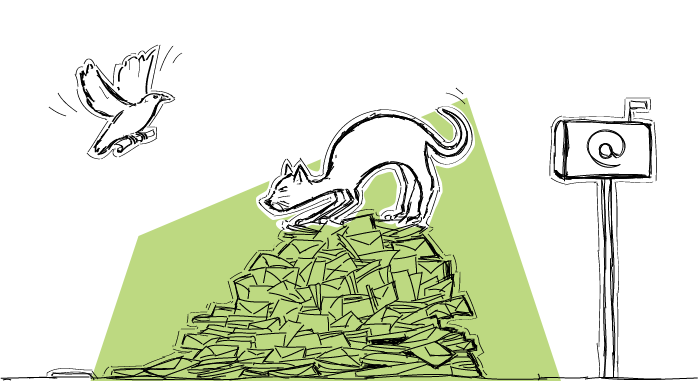
10 Reasons Why Your Cold Emails Are Getting No Response
This week we have a guest post by Nina Cvijovic, who is a researcher and writer at Etools. Nina analyzed 10 reasons why your outbound email campaigns may not be reaching the response rate you expect them to, or are not generating any responses at all. Either way, there's always a field for improvement in cold emailing. So go through the 10 checkpoints below, and read some advice on how your response rates can be improved.
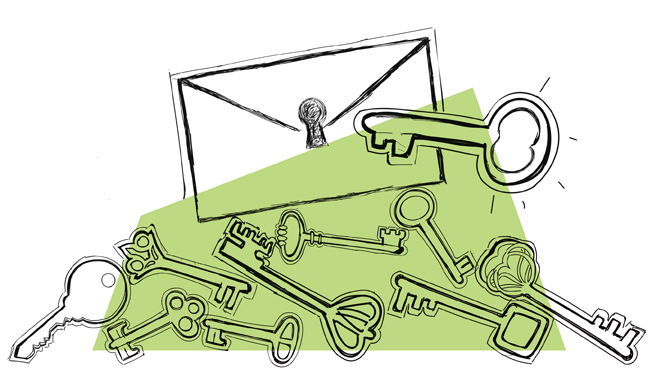
15 Best Subject Line Examples We’ve Come Across (Updated)
We always say that a cold email subject line is like a key to a door. Today, I present to you examples of attention-grabbing subject lines that will work like the right key to the right door and open up a conversation with your prospect. We analyzed the best sales email subject lines at Woodpecker and uncovered a really interesting thing that may help you. Keep on reading to find out what it is.

